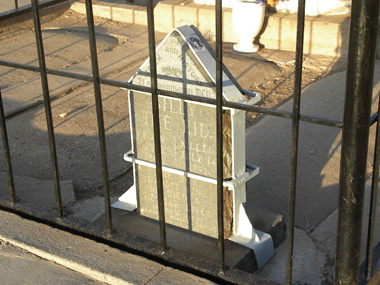|
I
Fort Sumner is famous for two reasons: Billy the Kid and The Long Walk. Although the story of Billy the Kid will never be as important as the very serious history of the Navajo’s Long Walk and imprisonment, the death of Billy the Kid is what draws most tourists to Fort Sumner. And actually the two stories share something — the same house. the death of Billy the Kid is what draws most tourists to Fort Sumner. And actually the two stories share something — the same house.
“Who is it?”
Sheriff Pat Garrett knew that the outlaw Billy the Kid was somewhere in the Fort Sumner area. On July 14, 1881, Sheriff Garrett set out to talk to one of Billy’s friends, Pete Maxwell. Near midnight, Garrett sat talking with Pete in Maxwell’s dark bedroom. Someone entered through the doorway. In the ensuing silence, the intruder whispered, “¿Quién es? ¿Quién es?” Garrett, recognizing the voice, fired twice in the dark, killing Billy the Kid.
Billy was buried the next day in the Fort Sumner military cemetery. A wooden cross marked his grave until the late 1880’s when the cross was said to have been taken to a museum back east. It was never recovered. Billy went without a gravestone for over 50 years.
“Where is it?” That famous marker was stolen in 1950. It was discovered 25 years later in a field near Granbury, Texas, and returned in 1976. In 1981, it was stolen again, but found a few days later in an alley in Huntington Beach, California. Governor Bruce King flew a sheriff out to California to retrieve it. Billy the Kid’s tombstone now sits behind an iron fence shackled to the ground itself.
And the House Where He Died? In 1869, the now abandoned Fort Sumner was bought by rancher Lucien Maxwell. He took the fort commander’s quarters for his own house. Of course, all these buildings had been built with the forced labor of the Navajos and Apaches. It was in this same house, with all that bad history, that Billy the Kid died in the bedroom of Lucien Maxwell’s son, Pete.
The old fort was eventually sold in the late 1880’s and the building salvaged. The homesite where Billy died is well-marked, but the house is gone.
 Jon Knudsen is a freelance writer and occasional guest on "New Mexico In Focus" (PBS). Email him at johnny_mango@yahoo.com. Jon Knudsen is a freelance writer and occasional guest on "New Mexico In Focus" (PBS). Email him at johnny_mango@yahoo.com.
|



